Low sodium salsa recipe that is an easy, fresh-tasting salsa recipe with canned tomatoes. Great option for a budget-friendly, homemade salsa that is delicious year-round.
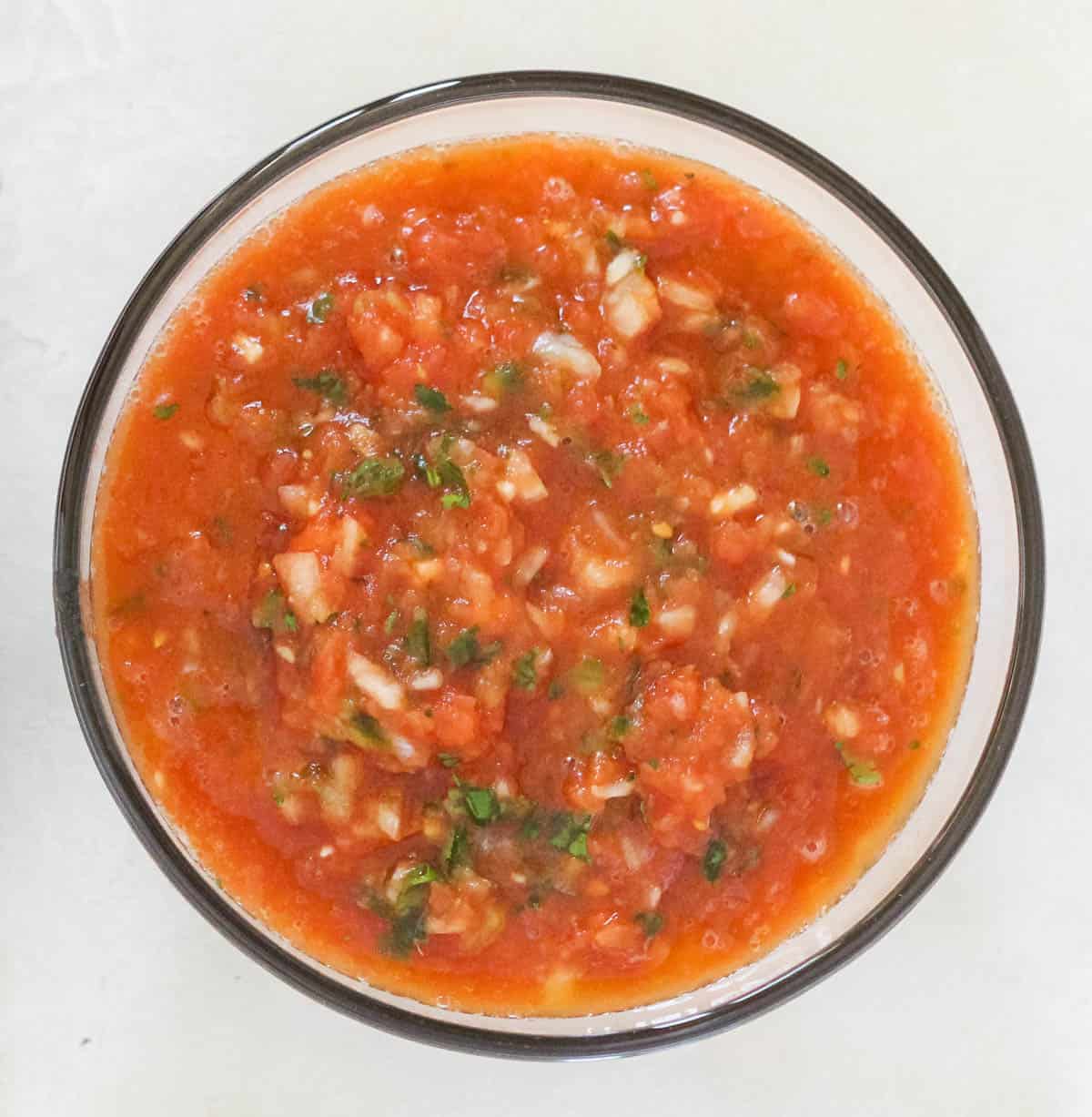
About Low Sodium Salsa
Looking for a salsa recipe with canned tomatoes? This one is for you!
The best part is that this recipe is for low-sodium salsa, yet it is still full of the salsa flavor you love.
One serving is ¼ cup of salsa (which is double the typical store-bought serving size of 2 tablespoons).
And if you use all of the salt called for in the recipe, it's still considered "low sodium."
Salsa is one of my absolute favorite condiments, snacks, appetizers, whatever; I love how versatile it is!
You can put salsa on almost everything, and it works well in multiple dishes like Instant Pot Salsa Chicken, Black Bean Salsa Tuna Salad, Salsa Turkey Lettuce Wraps, Salsa Lentil Soup, and Slow Cooker Salsa Verde Pork.
Not only is salsa full of nutrients, but it's also tasty and quite versatile.
So instead of forgoing salsa if you are conscious of your sodium intake, try making it at home so you can control the amount of salt used.
And in my opinion, homemade salsa is hard to beat compared to store-bought salsa.
(Nothing against store-bought salsa. I always have a few in my pantry, but this homemade salsa recipe low in sodium is nice if you need a salsa that is low in sodium or if you want salsa and don't have it)
This salsa is so simple, and it has only 7 ingredients including salt.
It's really inexpensive to make, and you can even make this in the winter when good tomatoes aren't available.
Another bonus: It's quick too! It takes about 10 minutes, from start to finish, to make the salsa.
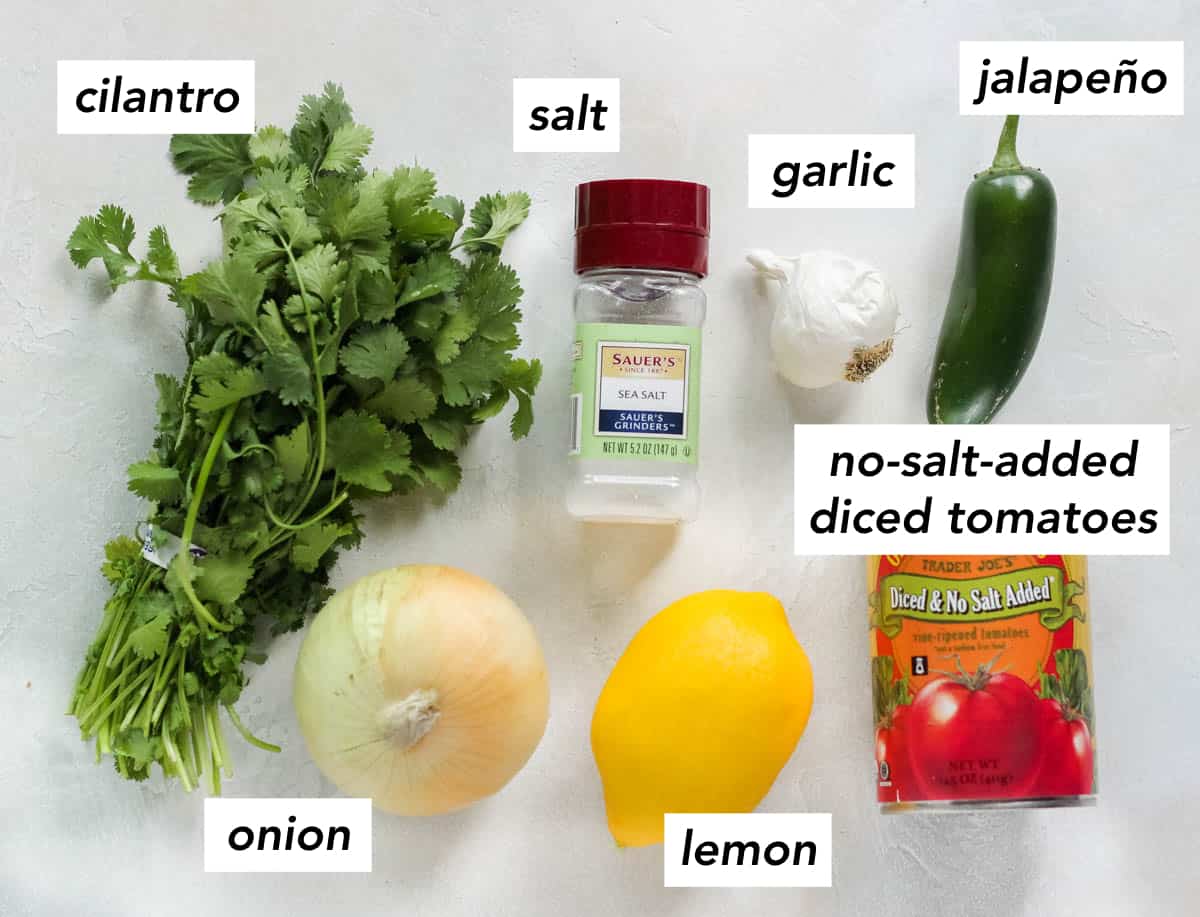
Ingredients
Canned diced tomatoes: Be sure to buy no-salt-added diced tomatoes. Otherwise, your salsa will no longer be lower sodium (and it will likely be salty).
The great thing about using canned tomatoes in this easy salsa is that you can make this salsa year-round and not have to worry about finding fresh, high-quality tomatoes.
As noted below in the substitutions, you can also easily use fresh tomatoes in place of canned ones. However, I recommend using them only when tomatoes are in season.
Onion: I use yellow onion, but most onions including yellow, white, sweet, or red onions, will work.
Depending on how much onion you like, you might want to play around with the amounts. I use about 1 cup of onions per can of tomatoes.
If you are not a big onion fan, use about half of a medium onion or one small onion. You can always add more if desired.
Be sure to wait a few hours before you add more because the onion flavor will develop over time.
Garlic: Fresh garlic is preferred. If you love garlic, feel free to add extra.
Cilantro: While not everyone is a fan of cilantro, it gives your salsa that authentic salsa flavor. Plus, it adds a little freshness.
You can easily skip it or use parsley in its place.
Jalapeño: The jalapeño is another ingredient, like cilantro, that makes this salsa taste more authentic and fresh, but you can skip it or use another spicy pepper.
Or replace the jalapeno with about ½ to 1 teaspoon of red pepper flakes.
Salt: Using a little bit of salt (¾ teaspoon for the whole recipe) helps really amp up the flavor of your salsa.
If you want to decrease the sodium more, start with ¼ teaspoon and add in ⅛ teaspoon increments as needed.
Be sure to note the sodium amounts per serving if sodium is something you are conscious of monitoring.
If you absolutely need this salsa to be a no salt added salsa, try adding a pinch of sugar to balance the taste of the canned tomatoes.
Lime juice: The acidic flavor of the lime juice helps cut the sweetness of the tomatoes and the sharp onion-jalapeño flavors. Lemon juice, apple cider vinegar, white wine vinegar, and red wine vinegar are other tasty options.
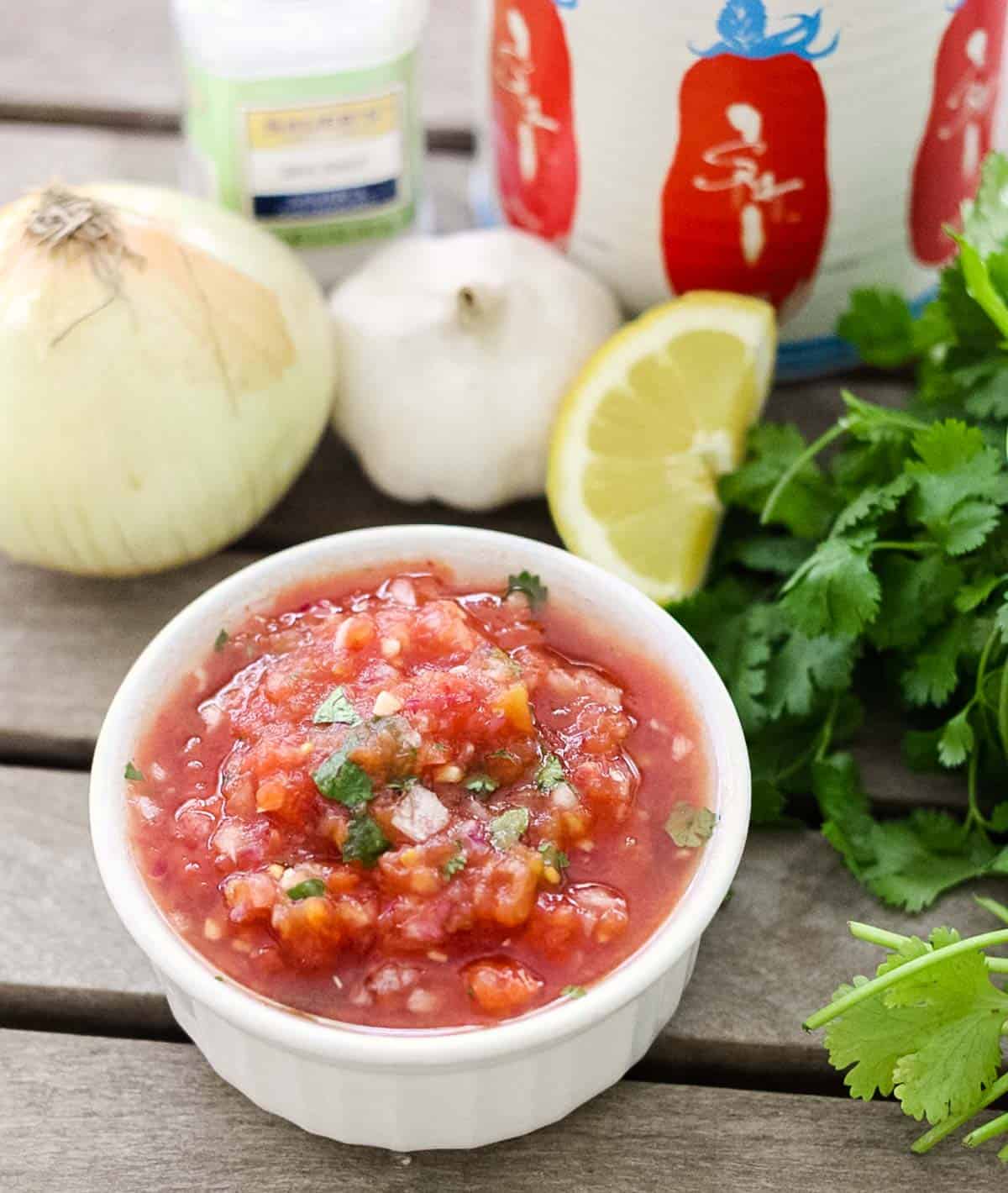
Recipe Cost
- No salt added diced tomatoes 2 cans: $1.76
- Onion, 1 medium: $0.50
- Garlic, 3 cloves: $0.18
- Cilantro, ¼ cup: $0.32
- Jalapeño, 1 small: $0.14
- Salt, ¾ tsp: $0.01
- Lime juice, 1 tablespoon: $0.22
TOTAL COST: $3.13 or $0.20/serving (Based on San Diego grocery stores 2023)
Note that this is not the recipe; it's simply to show the cost breakdown of ingredients. Scroll down to the full recipe to see the specific ingredients and directions.
Sodium in Salsa
This low sodium salsa recipe calls for ¾ teaspoon of salt, and a serving size is ¼ cup.
Here is a comparison of how much sodium is in a ¼-cup serving:
- no salt added: 6mg per serving
- ¼ teaspoon salt: 42mg per serving
- ½ teaspoon salt: 78mg per serving
- ¾ teaspoon salt: 115mg per serving
- 1 teaspoon salt: 151mg per serving
- store-bought: 400mg per serving
When it comes to labels, "low sodium" is considered 140mg or less of sodium per serving.
While "very low sodium is 35mg or less of sodium per serving.
It's recommended that "you consume less than 2300mg of sodium per day.
How to Make Low Sodium Salsa
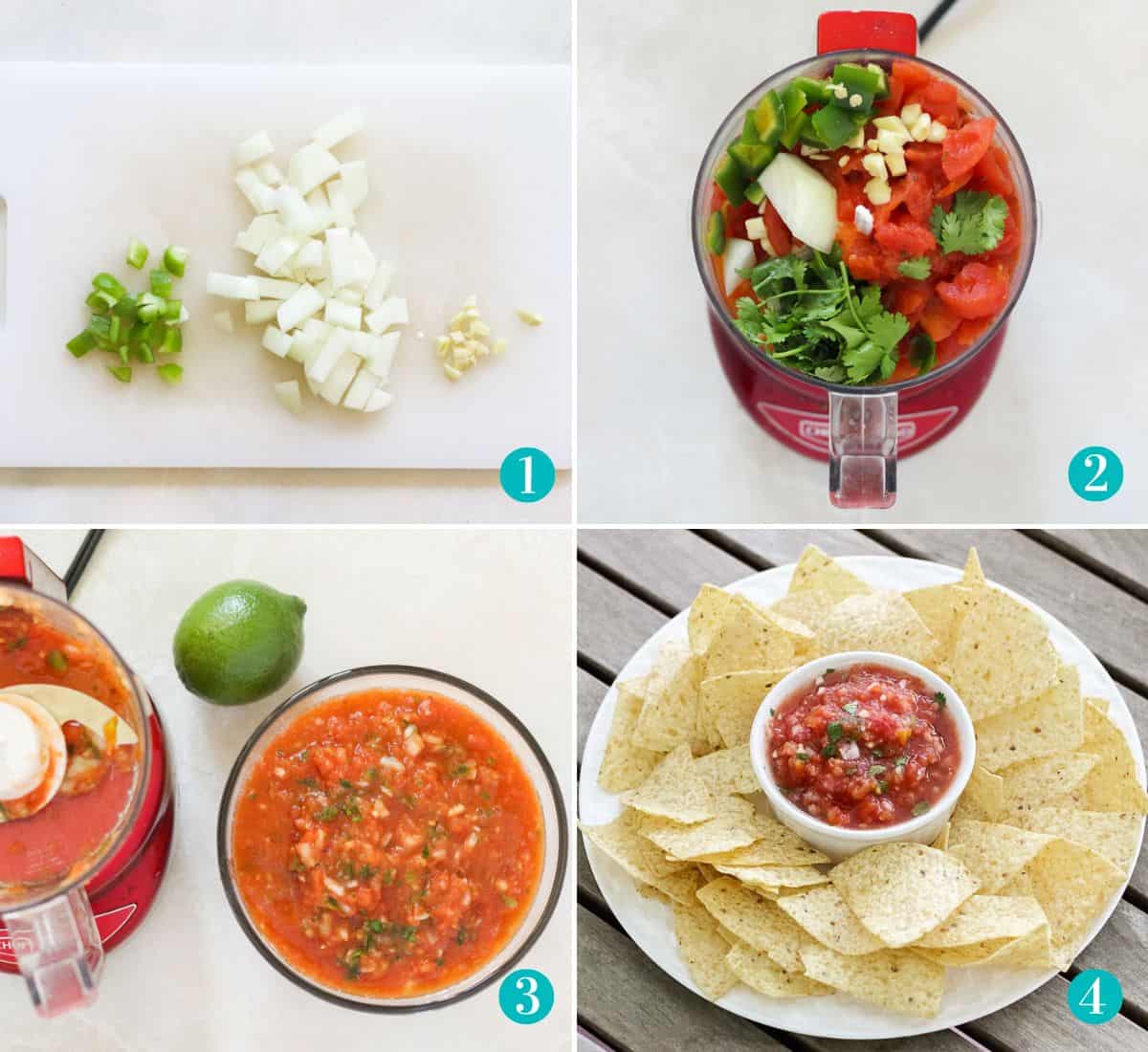
Time needed: 10 minutes
Easy Low Sodium Salsa is a fresh-tasting, homemade salsa recipe with canned tomatoes that can be made year-round. Plus, it's budget-friendly and vegan.
- Chop onion, garlic, and jalapeño.
- Add tomatoes (along with their juices), onion, garlic, cilantro, jalapeño, and salt to a food processor.
Pulse until it reaches your desired texture for salsa.
- Transfer to a bowl and add vinegar (or lemon or lime juice).
Refrigerate for at least a few hours to let the flavors come together.
- Enjoy!
Recipe Tips
This low sodium salsa recipe is great to get you started on perfecting your own tasty homemade salsa.
What's nice is that it is easily adaptable to what's in your kitchen and your taste preferences, so be sure to make this your own.
Here are some options for how you can update this recipe based on your personal preferences as well as what you have in your kitchen.
Variations
Ingredient Options
Flavor Substitutions
Tomatoes: Fresh tomatoes can be used in this salsa. You'll use about 3 cups of chopped fresh tomatoes.
Garlic: You can easily replace the fresh garlic cloves with ½ teaspoon to ¾ teaspoon of garlic powder.
Jalapeño: Use a different hot pepper in its place. Or omit the jalapeno for a more mild salsa.
For a pantry option, ½ to 1 teaspoon of red pepper flakes if you don't have a jalapeño. You can also use 1 (4 oz) can of diced green chiles.
Cilantro: Parsley can be used in place of cilantro or omit the fresh herbs altogether if desired.
Lime: You can easily use an equal amount of lemon juice in this salsa. Lime juice or lemon juice make this a fresher-tasting salsa.
But if you do not have either, apple cider vinegar, white wine vinegar, red wine vinegar, and white vinegar will also work.
I like the option to use vinegar because I always have that in my pantry and don't always have a lemon or lime.
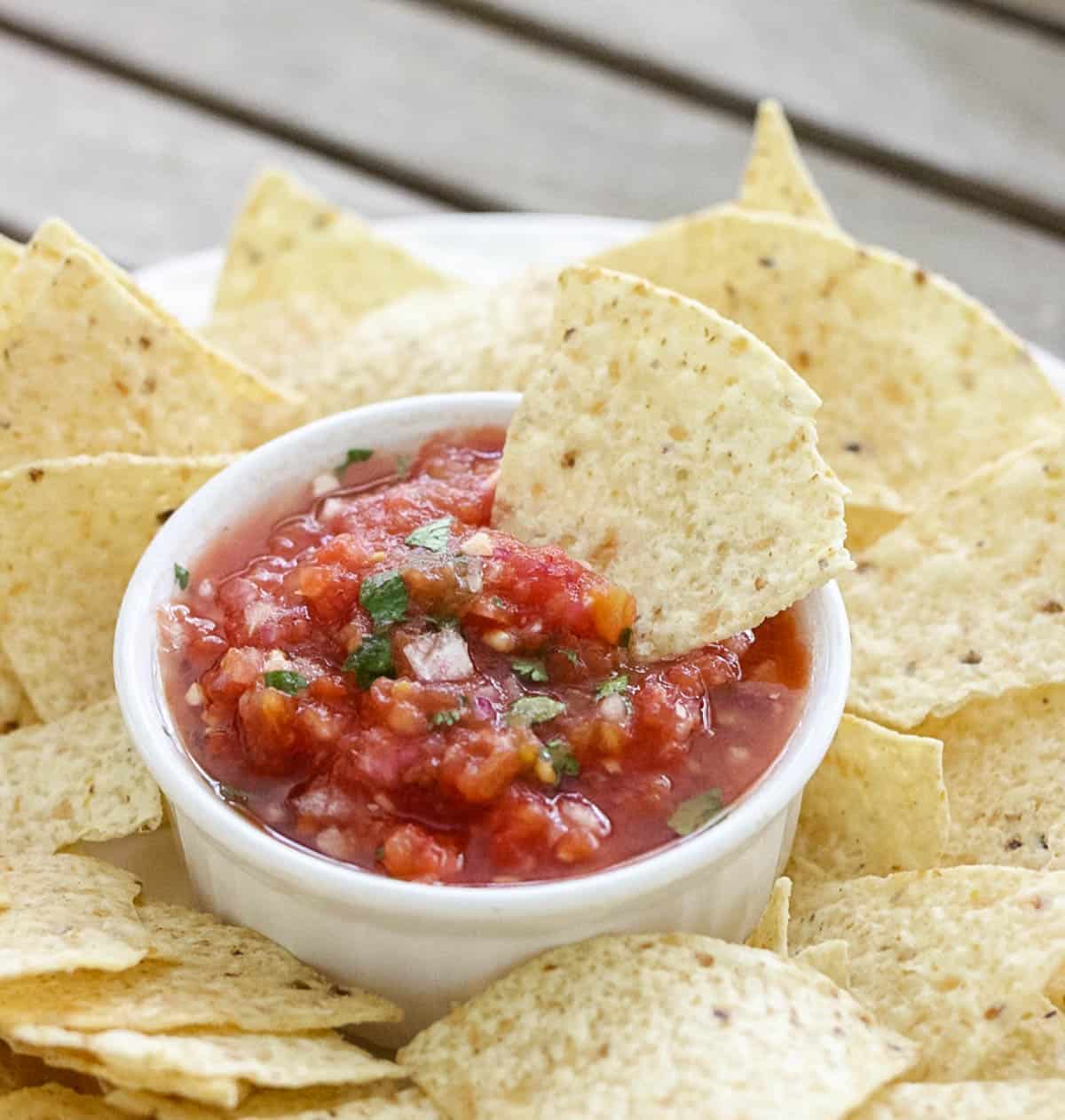
Alternative Prep & Cooking
If you don't have a blender, you can follow the directions using a blender in its place.
However, be careful not to puree the salsa if you're using a blender.
If you don't want to use or don't have a food processor or blender, you can easily make this low sodium salsa by dicing the onions & tomatoes, mincing the garlic, and chopping the cilantro to be the size you want in your salsa.
Then stir it all together, and it'll be equally as delicious!
How to Make Allergy-Friendly
No changes need to be made because this recipe is already allergy friendly since it's gluten-free, dairy-free, egg-free, and nut free.
It's also vegetarian and vegan, so it's a great recipe to make for parties since everyone can enjoy it.
How to Fix a Mistake
Forgot to buy jalapeño or cilantro: Skip them, or use one of the substitutions listed above.
Used too much onion or cilantro: Add extra tomatoes.
Lacks flavor: Add an extra dash of salt, or if trying to keep this lower in sodium, add extra lemon or lime juice or cilantro or onion or jalapeño depending on the flavor you feel is missing.
- For more heat/spice, use jalapeño.
- For brightness, add lemon or lime juice.
- For more herby flavor, add cilantro.
- For intensity, add onion.
Make-Ahead Ideas
Salsa is best made ahead!
You can also chop the onion, garlic, and jalapeño in advance if desired.
Storage Suggestions
Store the salsa in a glass or plastic container because the tomatoes and lime juice can negatively react to a metal container.
This low sodium salsa recipe keeps for up to 5-8 days in the fridge, tightly covered.
However, note that the salsa starts to look a little drab after about 5 days, so I recommend eating it by that time.
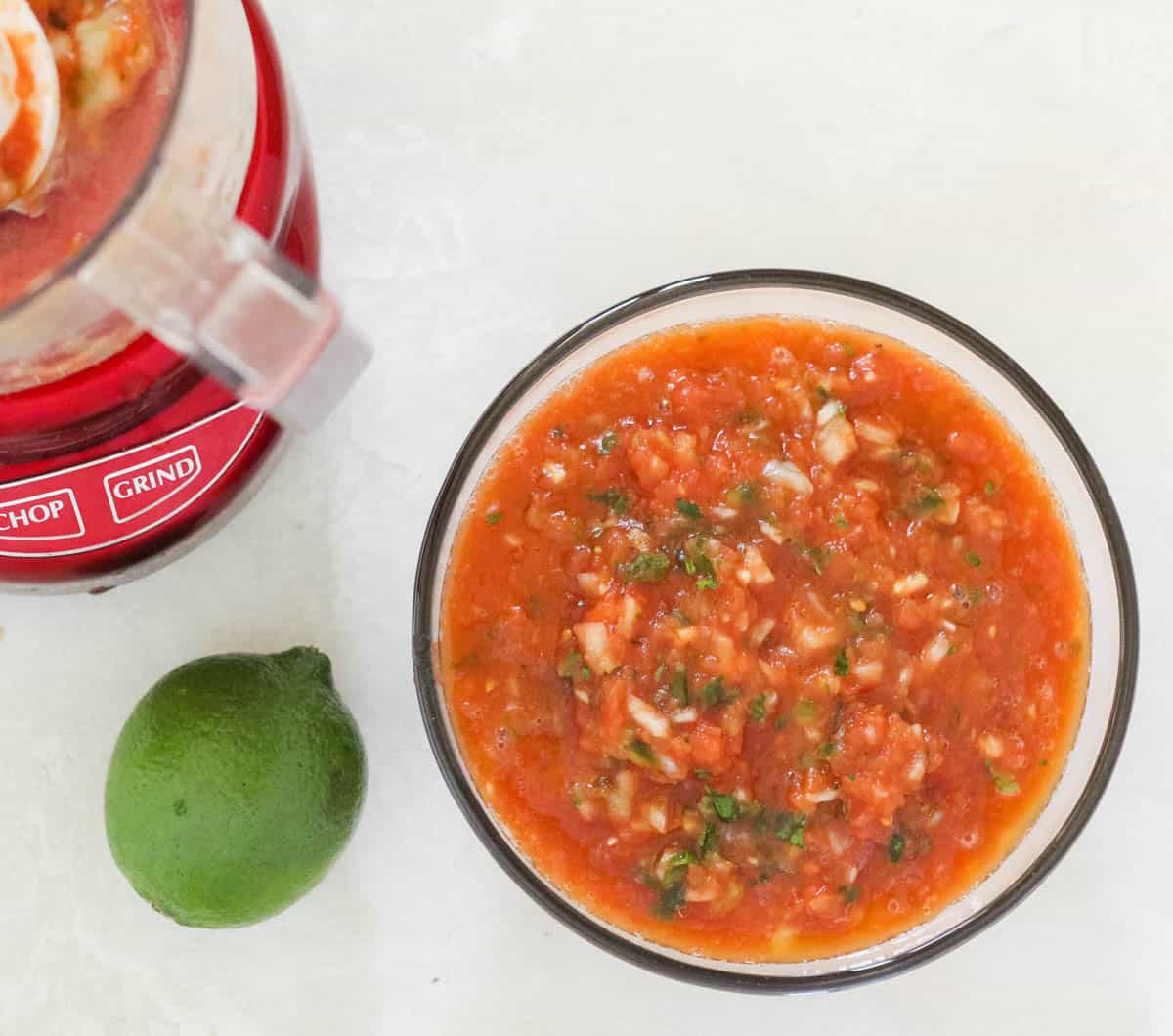
Frequently Asked Questions
Store bought salsa is often quite high in sodium, especially if you consume more than the 2 tablespoon serving size which already has around 125 to 400 mg of sodium depending on the type and brand.
Homemade salsa can be a great option because it is much lower in sodium since you control the ingredients.
For most jarred salsas, a 2-tablespoon serving has about 125 to 240mg sodium. Since most people eat more than only 2 tablespoons, the amount of sodium you can get from salsa can be quite high.
For example, if you eat ¼ cup (or 4 tablespoons), you get 400-500mg sodium in just the condiment. That's a lot if you are trying to limit or moderate your sodium intake.
For this homemade salsa with less sodium, a 4-tablespoon serving has about 115mg of sodium.
Follow the recipe below. Note that the serving size is 4 tablespoons and with that, you get around 115mg sodium (almost ¼ of the sodium in jarred salsa).
Feel free to lower the amount of salt to decrease the sodium even more.
Using only ½ teaspoon for the entire recipe gives you 78mg sodium per 4-tablespoon serving size. Using ¼ teaspoon for the entire recipe gives you 41mg of sodium for each serving. Making this a no salt added salsa has 6mg of sodium per serving.
It depends. Store bought salsa is high in sodium. Luckily, if you make it at home with this quick and easy low sodium salsa recipe, you can enjoy salsa on a low sodium diet.
Nutrition Benefits
The beauty of salsa is that it is made up of mostly veggies so it adds vitamins, minerals, and fiber to your meals when used as a condiment.
One serving gives you 8% RDA of Vitamin C and 1 gram of fiber.
It is also a great way to add flavor and nutrients.
While lacking in color, even the onions and garlic add benefits like anticancer, antiviral, anti-inflammatory, antiasthmatic, and antibiotic effects.
Plus, this salsa is low sodium, so it's great for those that want to enjoy salsa without the typically massive amounts of sodium in store-bought salsa.
What to Serve with Low Sodium Salsa
Chips, of course! But additionally, you can add this to almost anything.
Some of my favorites include Breakfast Stuffed Pepper, Avocado Black Bean Burger, Breakfast Tostada, Rotisserie Chicken Quesadilla, Healthy Nachos, and Marinated Tofu Tacos — even though I know I could name dozens more.
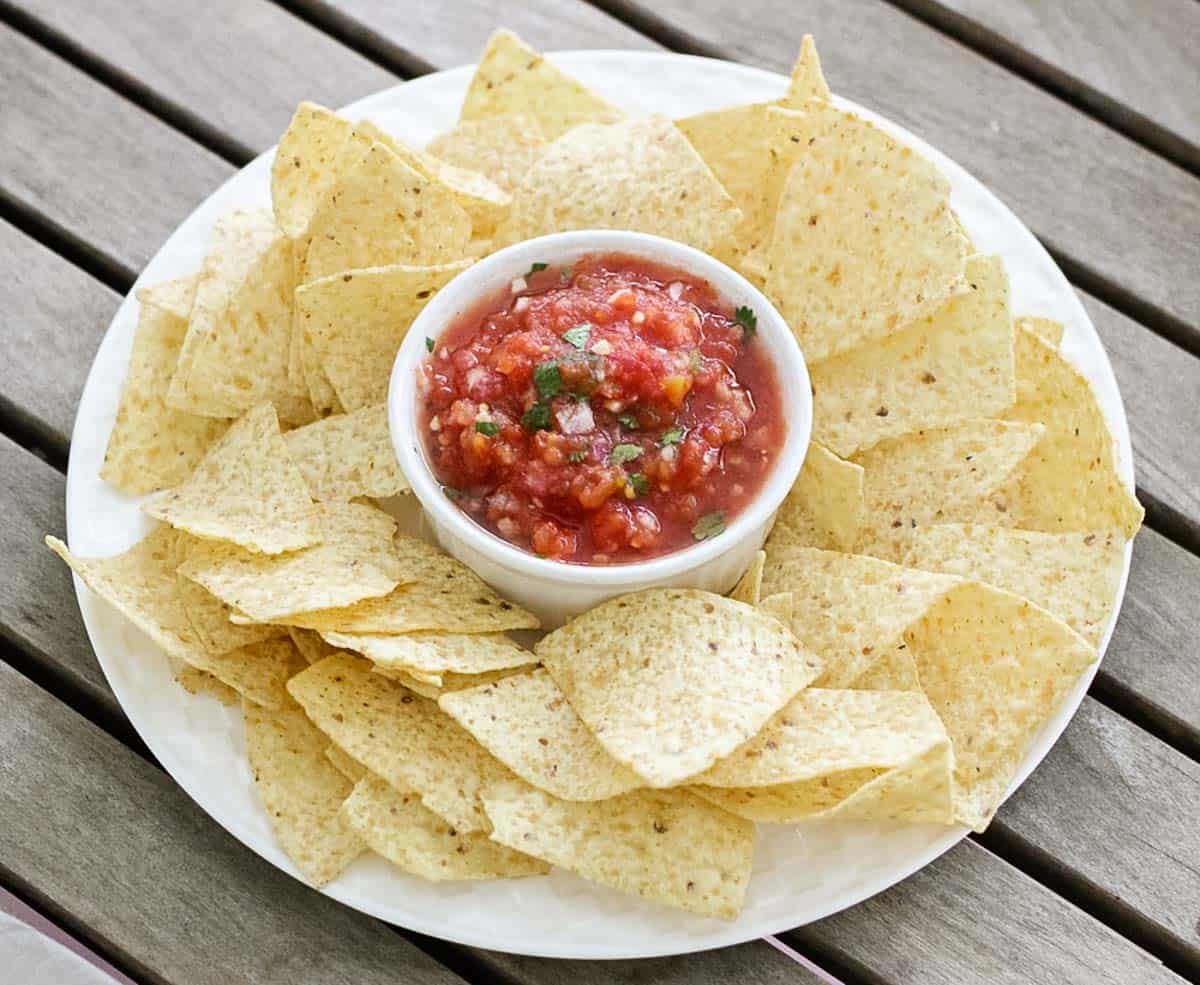
Final thoughts:
This salsa recipe with canned tomatoes is one of those recipes I come back to time and time again because it's simple, takes less than 10 minutes to prepare, can be modified based on what I have in my kitchen, and doesn't usually require a trip to the grocery store.
This easy homemade salsa recipe is a salsa recipe you can make at home with mostly pantry ingredients so it's budget-friendly.
And it has almost one-fourth of the sodium in jarred salsa!
The classic ingredients of salsa are hard to beat: tomatoes, cilantro, jalapeño, garlic, and onion.
However, it's a shame to only be able to enjoy homemade salsa when the tomatoes are ripe and seasonal.
That's why this salsa recipe is fab: because it uses canned tomatoes and other pantry ingredients so you can make this salsa year-round.
MORE LOW-SODIUM CONDIMENT RECIPES YOU'LL LOVE:
- Low Sodium Pizza Sauce
- Roasted Zucchini Sauce
- Low Sodium BBQ Sauce
- Spicy Pesto
- Cranberry Honey Mustard Sauce
- Mango Black Bean Salsa
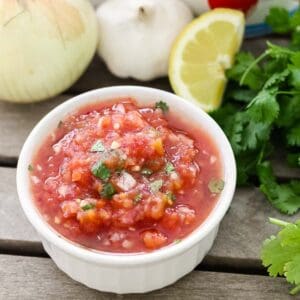
Low Sodium Salsa
Ingredients
- 1 medium onion roughly chopped
- 3-4 cloves garlic chopped
- ¼ cup cilantro or parsley
- 1 small jalapeño diced
- 2 (14.5 ounce) cans no-salt-added diced tomatoes undrained
- ¾ teaspoon salt *see notes
- 2 teaspoons lime juice or lemon juice, apple cider vinegar or white vinegar
Instructions
- In the bowl of a food processor, add the onion, garlic, cilantro, jalapeño, and tomatoes with their juices. Pulse until it reaches the consistency you prefer for your salsa.
- Transfer to a plastic or glass bowl, and stir in the salt and vinegar or lime juice.
- Refrigerate for at least 4 hours, so the flavors can do their thang. Taste and adjust seasoning if needed.
- Enjoy with chips, over omelets, with fish or chicken, the options are endless
Notes
What to Use in This Recipe
Meme
This post was originally published on May 2, 2012 - Text, recipe, and photos have been updated
Low Sodium Salsa Nutrition
How many Calories in Homemade Salsa? There are 13 calories for ¼ cup
How many Carbs in Salsa? there are 3 grams carbs in homemade salsa

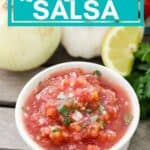
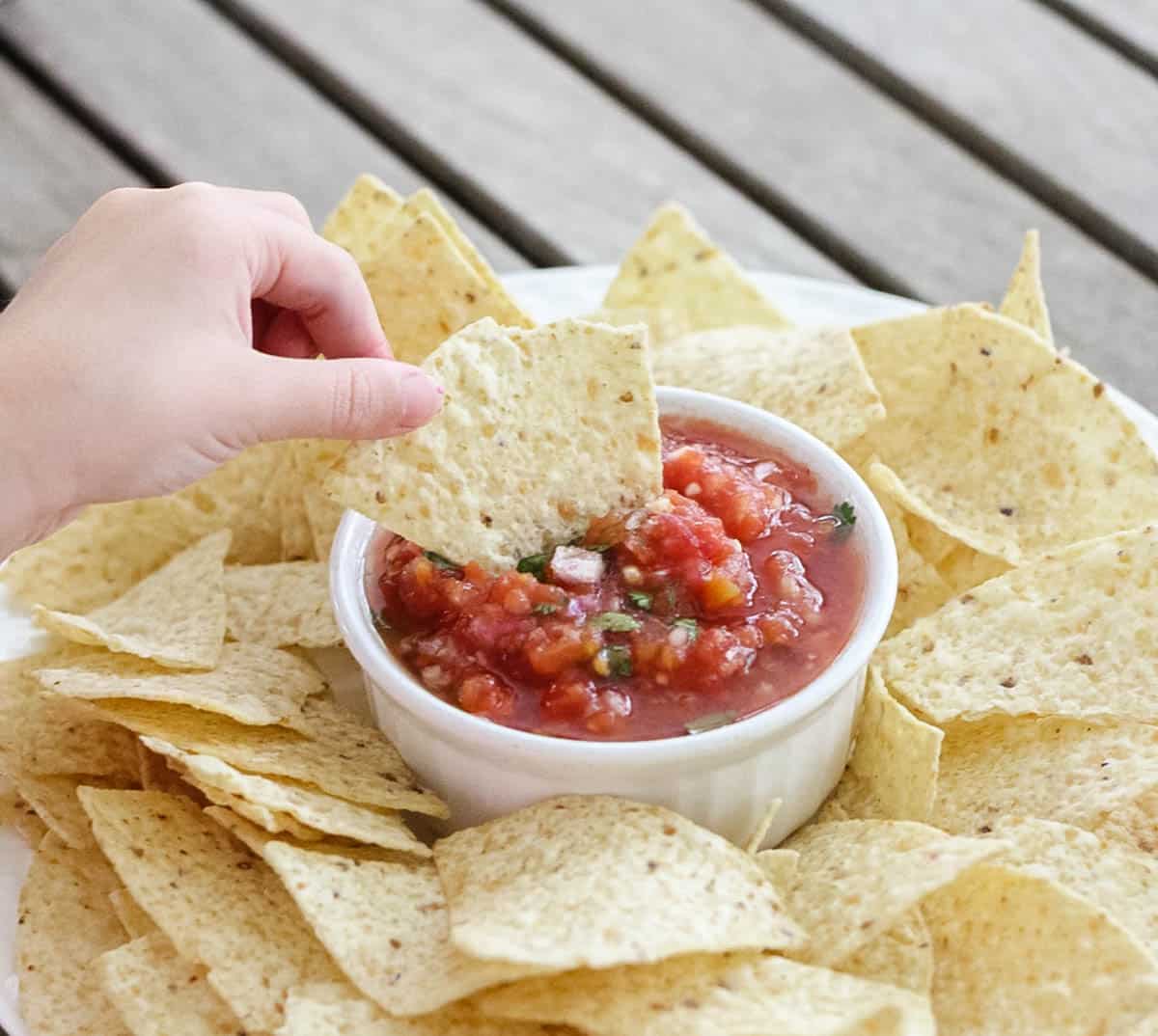


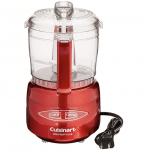
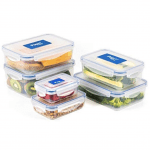
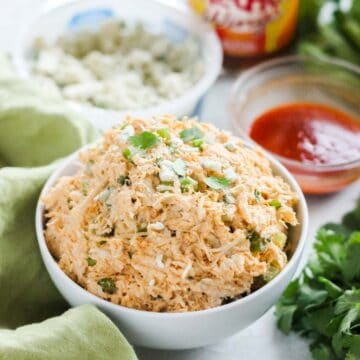
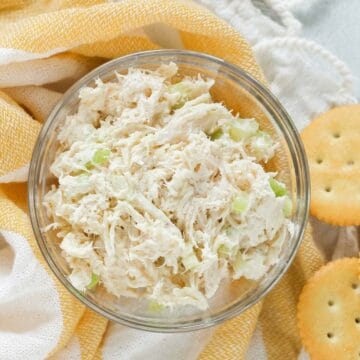

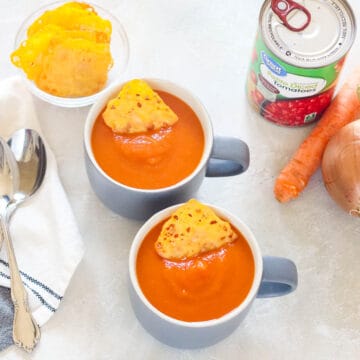
Mary
This is exactly what I've been looking for. It looks delicious and the sodium count is really low. I was shocked when I realized how much sodium was in the jarred salsa I was buying so I'm looking forward to trying this recipe. Thank you so much for posting it.
Mwell
Unsalted blue corn chips are pretty good, especially when dipping in salsa.
J. Maynard
Correction!!!:
The recipe calls for 1/4 tsp of salt; for about 115mg of sodium per serving.
Farther down, the recipe mistakenly states:
"Using only 1/2 teaspoon for the entire recipe gives you 78mg sodium. Using 1/4 teaspoon for the entire recipe gives you 41mg sodium."
It should say that one can use half the amount of salt called for (i.e. 1/8 tsp) or one fourth of the amount of salt called for (i.e. 1/16 tsp) to further reduce the amount of sodium.
As one who maintains a very low sodium intake for serious medical reasons, I see this as a very serious error.
Meme
Thanks for your comment... However, the actual recipe calls for 3/4 teaspoon which provides 115mg per serving. I mistakenly wrote 1/4 teaspoon in the section listing the COST of the recipe, but if you read all of the other sections, you'll see that the recipe is written using 3/4 tsp. I use a nutrition calculating software, and after double checking, the amounts listed in the recipe card are correct. I apologize for writing the incorrect amount in the cost of the recipe section, but the recipe and everywhere else is correctly listed using 3/4 teaspoon for the amount to use to get 115mg per serving.
I will go update the post now so there is no more confusion. Thanks for alerting me to this mistake!
Laurale Greathouse
Can also tell me the shelf like in fridge please
Thank you
Meme
Hi Laurale! This keeps for up to 5-8 days in the fridge, tightly covered. I find that it starts to look a little drab after about 5 days, so I recommend eating it by that time. Be sure to store in a glass or plastic container, too 🙂
Heather Kay
Great recipe!
Meme
Thanks so much!!! 🙂
Buddy Mostellar
This Salsa is off the charts! I used this for my Spanish project, and my whole family loved it. They described it as a chef's kiss. The salsa is very good and refreshing. I give it five stars. I would recommend it!!!!!!!
Meme
Yay!!! You're the best! Thanks so much 🙂